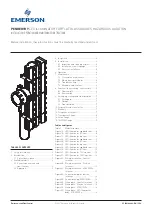
4
Technical Data
PR216-219-508-01
Effective March 2017
Installation and user manual for the
BiWire / Conventional Repeater
Power Supply Equipment (PSE)
The PSE has been specifically designed to operate the panel and
may not be substituted for any other power source . The PSE is a
Switch Mode Power Supply located within the cabinet as shown
below . A dedicated 230V AC mains supply is required as the
primary source; the supply is fused on the PCB by a 10 amp anti-
surge fuse . In the event of mains failure the PSE will automatically
switched over to the standby battery power source until the main
power source is restored .
The PSE maintains the charge for the two 12V 5Ah sealed lead
acid batteries in a fully charged state . On initial power up the
batteries will charge over a 24 hour period . Dependent on the
charge of the installed battery the system may initially show a
charger or battery fault .
The supply should be clearly labelled ‘FIRE ALARM: DO NOT
SWITCH OFF’ at all isolation points .
PSE faults originating from the following are indicated by the panel
using a dedicated repeater power fault indicator:
•
The loss of either power source
•
Failure of the charger circuit
•
High internal resistance of the battery
Figure 2 shows the location of the power supply . “PSE
Specification” on page 16 provides a full technical specification for
the power supply .
Note that the charging circuit will be in its high impedance state
(approximately 3V DC) if no batteries, faulty batteries, or only one
battery is connected . The full 27V DC (nominal) charging voltage
should be present if the correct batteries are connected .
In order to test for correct operation of the batteries, remove the
mains 230V AC fuse and allow the batteries to settle from their
charging voltage for approximately 5 minutes . The battery voltage
should then be measured using an electronic test meter and a
voltage greater than 24V DC should be present .
Figure 2. Power Supply Equipment
BATTERY DISPOSAL INSTRUCTIONS
WARNING
RISK OF EXPLOSION IF BATTERY IS REPLACED BY AN
INCORRECT TYPE
This product contains batteries and they must be disposed of in
accordance with current waste disposal and pollution legislation
and in particular The Environmental Protection Act 1990, Special
Waste Regulation 1996 . It is recommended that the following
authorities are contacted before any attempt is made to dispose
of batteries; Environment Agency Local office, Local Authority
Environmental Health or Waste Handling department .
The batteries and fire panel comply with WEEE
disposal regulations . Do not dispose in general indus-
trial or household waste . Return unwanted products to
a designated collection point for waste electrical and
electronic equipment recycling .



































